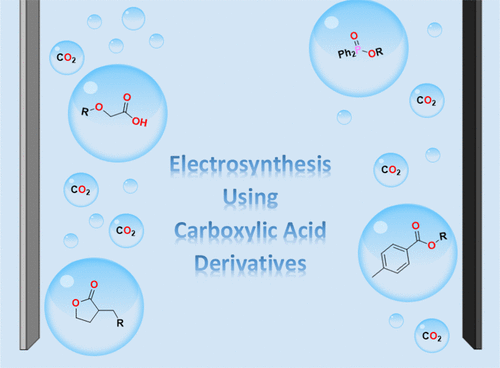当前位置:
X-MOL 学术
›
Acc. Chem. Res.
›
论文详情
Our official English website, www.x-mol.net, welcomes your feedback! (Note: you will need to create a separate account there.)
Electrosynthesis Using Carboxylic Acid Derivatives: New Tricks for Old Reactions.
Accounts of Chemical Research ( IF 18.3 ) Pub Date : 2020-01-02 , DOI: 10.1021/acs.accounts.9b00586 Matthew C Leech 1 , Kevin Lam 1
Accounts of Chemical Research ( IF 18.3 ) Pub Date : 2020-01-02 , DOI: 10.1021/acs.accounts.9b00586 Matthew C Leech 1 , Kevin Lam 1
Affiliation

|
Electrosynthetic organic chemistry is an old discipline that takes its root in Faraday's seminal works. The field has a rich history and is in the midst of a renaissance, due to the growing impetus of the chemical community to develop greener, more economical, and more efficient synthetic methodologies. Indeed, electrosynthesis relies on one of the greenest and cheapest reagents in the world: the electron itself. In this Account, the recent developments in the use of carboxylic acid derivatives in electrosynthesis are summarized. Until lately, the fate of the monoelectronic reduction of aromatic esters in nonprotic solvents remained unclear. Recent investigations have shown that aromatic esters are reduced and form surprisingly long-lived radical anions. Under the right conditions, these radical anions decompose into the corresponding carboxylates and alkyl radicals. These principles have been used to develop a novel electrochemical alcohol deoxygenation reaction using aromatic esters as stable and versatile radical precursors. In contrast to esters, the electrochemistry of carboxylic acids has been intensively studied. Pioneering works by Faraday and Kolbe in the late 1800s have revealed that the anodic oxidation of carboxylic acids leads to a radical decarboxylation. Interestingly, radical recombination is observed due to the very high concentration of radicals in the vicinity of the electrode. Such radical recombination is rarely observed during classical homogeneous radical reactions. The "Kolbe" reaction and its carbocationic variation have been intensively used across the fields due to their versatility. As we will develop in this Account, almost two hundred years after its discovery, the anodic decarboxylation of carboxylic acids is still relevant to modern organic chemists. For instance, we will examine how the non-decarboxylate Kolbe reaction of aromatic acids forms aroyloxy radicals and how oxycarbonyl radicals could be generated from hemioxalates. Finally, the carbocationic variant of the Kolbe reaction, known as the Hofer-Moest reaction, will be examined in the context of two newly developed reactions: a green MOM-type ether formation and the use of malonic acid derivatives as carbonyl synthons. Electrosynthesis is a powerful synthetic tool. Even if it might still be underutilized at the moment, there is little doubt that it will become one of the "classic" methods to activate small organic molecules in a very near future.
中文翻译:

使用羧酸衍生物进行电合成:旧反应的新技巧。
电合成有机化学是一门古老的学科,扎根于法拉第的开创性著作中。由于化学界越来越多的动力来开发更绿色,更经济和更有效的合成方法,因此该领域具有丰富的历史,并且正处于复兴之中。实际上,电合成依赖于世界上最绿色,最便宜的试剂之一:电子本身。在该报告中,总结了在电合成中使用羧酸衍生物的最新进展。直到最近,在非质子溶剂中单电子还原芳香族酯的命运仍不清楚。最近的研究表明,芳族酯被还原并形成令人惊奇的长寿命自由基阴离子。在适当的条件下 这些自由基阴离子分解成相应的羧酸根和烷基。这些原理已被用于开发一种新的电化学醇脱氧反应,该反应使用芳族酯作为稳定和通用的自由基前体。与酯相反,已经深入研究了羧酸的电化学。法拉第(Faraday)和科尔贝(Kolbe)在1800年代后期的开创性工作表明,羧酸的阳极氧化会导致自由基脱羧。有趣的是,由于在电极附近的自由基浓度很高,因此观察到自由基重组。在经典的均相自由基反应过程中很少观察到这种自由基重组。由于其多功能性,“ Kolbe”反应及其碳阳离子变化已在各个领域得到广泛应用。正如我们将在此帐户中开发的那样,在发现后将近200年,羧酸的阳极脱羧仍然与现代有机化学家有关。例如,我们将研究芳族酸的非脱羧Kolbe反应如何形成芳酰氧基,以及如何从半草酸酯中产生氧羰基。最后,将在两个新开发的反应的背景下检查Kolbe反应的碳阳离子变体,即Hofer-Moest反应:绿色MOM型醚的形成和丙二酸衍生物作为羰基合成子的使用。电合成是一种强大的合成工具。即使目前仍未得到充分利用,毫无疑问,它将在不久的将来成为激活有机小分子的“经典”方法之一。
更新日期:2020-01-04
中文翻译:

使用羧酸衍生物进行电合成:旧反应的新技巧。
电合成有机化学是一门古老的学科,扎根于法拉第的开创性著作中。由于化学界越来越多的动力来开发更绿色,更经济和更有效的合成方法,因此该领域具有丰富的历史,并且正处于复兴之中。实际上,电合成依赖于世界上最绿色,最便宜的试剂之一:电子本身。在该报告中,总结了在电合成中使用羧酸衍生物的最新进展。直到最近,在非质子溶剂中单电子还原芳香族酯的命运仍不清楚。最近的研究表明,芳族酯被还原并形成令人惊奇的长寿命自由基阴离子。在适当的条件下 这些自由基阴离子分解成相应的羧酸根和烷基。这些原理已被用于开发一种新的电化学醇脱氧反应,该反应使用芳族酯作为稳定和通用的自由基前体。与酯相反,已经深入研究了羧酸的电化学。法拉第(Faraday)和科尔贝(Kolbe)在1800年代后期的开创性工作表明,羧酸的阳极氧化会导致自由基脱羧。有趣的是,由于在电极附近的自由基浓度很高,因此观察到自由基重组。在经典的均相自由基反应过程中很少观察到这种自由基重组。由于其多功能性,“ Kolbe”反应及其碳阳离子变化已在各个领域得到广泛应用。正如我们将在此帐户中开发的那样,在发现后将近200年,羧酸的阳极脱羧仍然与现代有机化学家有关。例如,我们将研究芳族酸的非脱羧Kolbe反应如何形成芳酰氧基,以及如何从半草酸酯中产生氧羰基。最后,将在两个新开发的反应的背景下检查Kolbe反应的碳阳离子变体,即Hofer-Moest反应:绿色MOM型醚的形成和丙二酸衍生物作为羰基合成子的使用。电合成是一种强大的合成工具。即使目前仍未得到充分利用,毫无疑问,它将在不久的将来成为激活有机小分子的“经典”方法之一。



























 京公网安备 11010802027423号
京公网安备 11010802027423号